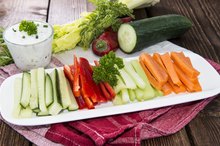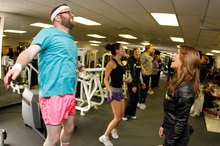How Many Calories Should I Eat to Lose Belly Fat?
If you struggle with belly fat, it’s a good idea to shed the extra pounds. Weight accumulation around the midsection increases your risk for cardiovascular disease and diabetes. Eating healthier foods and cutting back on calories promotes belly fat loss. Eating the right foods will help you get the necessary nutrition without feeling hungry.
Calorie Consumption
Weight gain occurs when you consume more calories than your body needs. The excess energy is stored as fat, which causes belly fat. The amount of calories you need varies based on your gender, age and activity level. Women’s calorie needs are generally less than men’s. Women ages 19 to 30 need about 2,000 to 2,200 daily calories with moderate activity, according to the American Heart Association. Women ages 31 to 50 need about 2,000 daily calories. As you reach age 50, your calorie needs decline to 1,800 daily. To lose belly fat, reduce your calorie intake slightly below these levels, depending on your age. Once you reach your fat loss goal, resume the recommended calorie intake to maintain a healthy body weight.
- Weight gain occurs when you consume more calories than your body needs.
- To lose belly fat, reduce your calorie intake slightly below these levels, depending on your age.
Maximizing Calorie Intake
Diet Plan to Lose 50 Pounds
Learn More
Lose belly fat by selecting foods that are low calorie and leave you feeling satisfied. For example, fruits and vegetables such as melon, berries, apples, spinach, broccoli and cauliflower are good choices. Whole grains, like oatmeal, brown rice and whole-wheat pasta are a few more choices. Select lean sources of protein, such as fresh water fish and chicken without the skin. Also, eat low-fat dairy sources, such as skim milk and cottage cheese.
- Lose belly fat by selecting foods that are low calorie and leave you feeling satisfied.
- Select lean sources of protein, such as fresh water fish and chicken without the skin.
Belly Fat Foods
When planning your calorie intake, also consume foods that promote midsection weight loss. For example, foods that are high in omega-3 fatty acids, like salmon or flaxseed, improve your metabolism, according to “Fitness” magazine. Eat about an ounce of almonds daily. This food is high in magnesium, which aids in energy production and building lean muscle mass. Almonds also keep blood sugar levels stable, preventing overeating.
- When planning your calorie intake, also consume foods that promote midsection weight loss.
- For example, foods that are high in omega-3 fatty acids, like salmon or flaxseed, improve your metabolism, according to “Fitness” magazine.
Foods to Avoid
What Happens to Sugar Levels in the Blood While Fasting?
Learn More
Avoid high-calorie snack foods, such as cookies and chips. Also, avoid foods that are high in saturated fats. Select beverages such as water or unsweetened tea instead of soda and juice. Calories in high-sugar beverages add up significantly over the course of the week. When eating fats, stick to monounsaturated or polyunsaturated fats found in vegetable oil and avocados.
- Avoid high-calorie snack foods, such as cookies and chips.
Related Articles
References
- American Heart Association: Know How Many Calories You Should Eat
- Centers for Disease Control and Prevention: How Much Exercise do I Need?
- Fitness Magazine: The 10 Best Foods for Flat Abs
- Sharma HB, Kailashiya J. Gender difference in aerobic capacity and the contribution by body composition and haemoglobin concentration: a study in young indian national hockey players. J Clin Diagn Res. 2016;10(11):CC09–CC13. doi:10.7860/JCDR/2016/20873.8831
- Brightwell CR, Markofski MM, Moro T, et al. Moderate-intensity aerobic exercise improves skeletal muscle quality in older adults. Transl Sports Med. 2019;2(3):109–119. doi:10.1002/tsm2.70
- American College of Sports Medicine. Protein Intake for Optimal Muscle Maintenance.
- Bellemare F, Jeanneret A, Couture J. Sex differences in thoracic dimensions and configuration. American journal of respiratory and critical care medicine. 2003;168(3):305–12.
- Dilgate Muth, Nathalie, MD, MPH, RD. Do men and women have different nutritional needs? American Council on Exercise. March 21, 2012.
- Lewis D, Kamon E, Hodgson J. Physiological differences between genders. Implications for sports conditioning. Sports medicine (Auckland, N.Z.). 1986;3(5):357–69.
- Protein Intake for Optimal Muscle Maintenance, American College of Sports Medicine, (2015).
Writer Bio
Nicki Howell started her professional writing career in 2002, specializing in areas such as health, fitness and personal finance. She has been published at health care websites, such as HealthTree, and is a ghostwriter for a variety of small health care organizations. She earned a Bachelor of Science in business administration from Portland State University.









